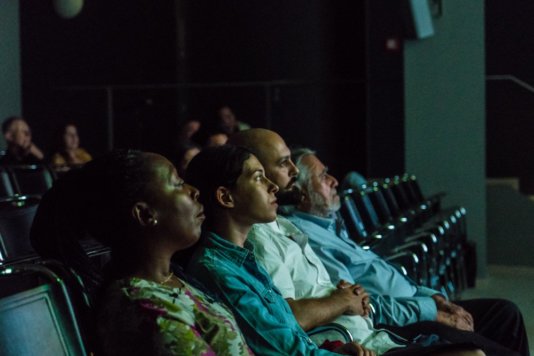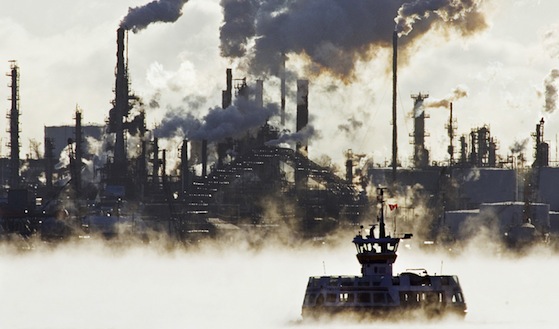- About
- Topics
- Picks
- Audio
- Story
- In-Depth
- Opinion
- News
- Donate
- Signup for our newsletterOur Editors' Best Picks.Send
Read, Debate: Engage.
| December 16, 2019 | |
|---|---|
| topic: | Arts |
| tags: | #Newton Harrison, #environment, #human rights |
| located: | Germany, Portugal, USA |
| by: | Hanno Hauenstein |
Long before global warming entered public consciousness, they considered its effects through maps, talks, and various other artistic means. They collaborated with biologists, historians, architects, and urban planners to initiate dialogues on biodiversity, climate change, and community development. Their artworks pushed the boundaries of what constitutes art. A conversation on the state of affairs.
FairPlanet: Is your home your studio space?
Newton Harrison: Yes, I actually designed my house in a way where every room is a thought-producing site.
You recently gave a lecture on your work in Berlin. What’s your connection to Europe?
Helen and I lived in Berlin while the wall was still up. We did work for documenta 8 during the 80s, which was called “Kassel Works”. The work was meant as a critique of documenta itself, and Kassel’s history, with the Gestapo headquarters that used to be located there. It was an out-front attack on the Hitler generated planning that shaped the rebuilding of Kassel after firebombing. When then President, von Weizsäcker saw this work, he immediately understood what we were doing and why and asked us to come work in Berlin. That’s how we ended up there. And that’s when we started working in Europe much more heavily.
What projects stood out for you during this time?
We did “Peninsula Europe”, which was funded by the EU and the German government and took up about 300 square metres of museum space. The work addresses the high grounds of Europe from the perspective of its drain basins, its ecosystems and waters. At the time the work was done, in 1999, we believed that Europe’s water supply was going to get badly affected, partly by drought, partly by profound misuse of waters. So we argued that a new kind of forestry running across the central massive right into Portugal needed to happen. We proposed concrete reforestation and created a first map, which was basically re-mapping all of Europe. We designed new continental high grounds, however not along the outlines of Europe, but from where all the rivers began. Every map we designed is a complex narrative, and it is almost always about biodiversity. You need to understand: every regular map is almost always about how to get from here to there, and thereby places here and there. What we did was to create a new ecologically-driven narrative.
How would this narrative map influence Europe as a whole?
If applied, Europe would basically change into a large number of city-states. We yank out the roads, intensify the rivers, intensify the high grounds, take out all national boundaries. As simple as that.
What was the thought process behind this idea?
When you look at Portugal, you see water retention landscapes, that let you produce food in dry climates. We propose that something like 100,000 of those landscapes would be made. They would basically function like small villages. Eventually, this would eliminate monocultural farming and reinstate biodiversity in the countryside, while creating a new kind of farming. That’s the kind of transformation we’re looking at, one which not only fixes temporary problems, but looks for a transformation of the whole system.
You and Helen both used to work as scientists. At which moment did you move to art?
We were the first couple that ever shared a single professorship at a university. That was in the early sixties, and we were both very active in the peace movement. But we were looking for deeper ways of encounter and political action. Helen read this book, Silent Spring, by Rachel Carson, which influenced her greatly, and me, too. By 1969, we understood that extinction was an actual possibility and that global warming would happen. It was right in our faces! Any smart person who studied the figures could see this by 1970. So we decided to do work that benefited the ecosystem. Also we were not scientists, but artists able to do science when needed.
And how was that work received at the time?
Well, once we were asked to do a piece on endangered species for a show in New York, and we said, look, ‘the most endangered species isn’t actually the lion, tiger or the hippopotamus that everyone is so romantic about. The most endangered species is topsoil’. About 12 million square miles of topsoil across the planet are being ruined because of all the carbon released to the atmosphere and the so-called green revolution which from the perspective of agri-business has turned into the green devolution. So, as one of our first projects, we made earth. We started these urban farming projects as art pieces. It’s a hard process. In order to make rich topsoil, it takes three full months, about 2.000 earthworms, four tons of shit, leaf mould, little clay, little sand, and pissing on it from time to time.
How did this become art?
Everything I do or we did is art. We understood we had to change our field and become what I would call “public service artists.” Galleries started showing urban gardens, transplanted meadows and plantations of ours. But our research process was equally important. We could foresee almost everything we’re facing today. We created a map of the world in which the rising of ocean levels is predicted precisely.
Why is it so hard to change people’s mind on this issue?
Well, somehow, people back then in the early 70s, like people today, seem to prefer death and total transfiguration to the loss of capital. What does this tell you? There’s something deeply wrong with capitalism itself. You heard of Herbert Marcuse? He used to be at my university back in the days. In the early 70s he and I had a meeting, we were talking and he says to me: ‘Newton, your work is as useless as the women’s movement.’ And I said, ‘Oh, really?’. He said, ‘Yes, it’s a form of regressive de-sublimation’. Which was code for: ‘You’re working on less important things than the class struggle.’ I lost my temper at him, I said ‘Herbert, the Uber-class is the whole human race. The Unter-class is the whole ecosystem. Anybody can screw the Unter-class with a shovel’. A few years later he came over and admitted I might have had a point here.
There was a point where your art projects were taken up by city planners, like in “A Vision for the Green Heart of Holland” project. Can you tell me about this?
Sure, they were going to put 600,000 houses, farming units, schools, etc. right into the centre of the so-called Green Heart. The Green Heart is a huge diverse farming operation centering a ring of cities including Amsterdam, Rotterdam, Utrecht and others. Its landforms represent the very history of Holland and formation of democracy. It’s about 800 square kilometres, consisting of mainly small villages and windmills. They were going to give it up. Also, it’s the great central park of Holland. So we got called up to create a plan for the Green Heart, which we did, by generating a new plan. And by pointing out other areas where they could easily put 600,000 houses while still encouraging biodiversity in the urban, suburban and agricultural communities.
For a 1971 exhibit in Boston you created “Hog Pasture”, in which you created an actual pasture indoors hoping to have a real hog root in it, but the museum refused. In 2012, the Museum of Contemporary Art, Los Angeles allowed you to re-create the work with a real pig.
Yes, the pig’s name was Wilma. It turned out that Wilma had never been in a natural environment before. She didn’t know what to do with that hog pasture! Usually, pigs just walk around and eat the roots. So I had to push Wilma’s nose into the ground, into the roots, and suddenly her tail started to wag 100 miles an hour. She dug up the whole artwork. It’s an interesting thing to observe, a really, really happy pig.
What do you think is our most pressing challenge for the future?
Look, in America today, oil lobbyists are buying politicians for whatever purposes they want. It’s not a democracy anymore. As long as the system keeps operating as it currently does, we will mostly die. Only small groups in small villages maybe near the north pole maybe can survive this. The last time planet earth underwent such a change from cold to warm, it took about 2,000 years, so there was relatively lots of time to adapt. Today it’ll take about 100 years. There simply is no time to adapt. Most of the conversations that have to happen, and that Helen and I tried to push for decades, is need to focus on what I call “paleo-botanical research”. We need to find out more about species that used to live in much warmer conditions and conducted a sort of migration not through space, but through time. With this knowledge one might slow down extinctions, so that there would be a fair survival rate. If we don’t invest in such research, there won’t be any increase of survival rate, civilisation will simply collapse. Or do you have a better idea?
Certainly not. In recent years, especially over this and last year, there is growing attention to the topic. Climate issues have driven elections. What’s your thoughts on this shift?
We have think about those issues in a long-term scale. Basically, what we have to do everywhere to help the climate today is take care of about 10.000 hectare of forests for about 200 years, and you’ll have an ancient forest, It generally takes 200-400 years. But in 20 years from now, it’s already going to get so much hotter that species will have to move and entire ecosystems will need to regroup at best. At worst, they will fail.
What are you working on at the moment?
I’m working on a number of projects. One of them includes an idea for the borderline between North and South Korea. If they created a giant biodiversity corridor between their countries, this area could teach them how to rehab their countries ecologically as this becomes a greater necessity in the future.
Could this translate into politics?
Of course. In order to realise this idea, they would need a kind of giant central park between their countries. If you look at North Korea today, there’s rarely a single tree standing. They did such bad farming and treated their people so bad when it got cold, so now there’s hardly any trees left.
How does the ideal future look like for you?
I don’t have one. But the things I’d like to see happen are these: a complete revision of capitalism, so that’s it’s understood that the ultimate capital is not money, but the overproduction of the life web itself. Look at crabs: the mother crab produces three million eggs. She expected, maybe, 30 eggs to live. So why did she make millions of eggs for few to live? It’s a survival package that constitutes food for many other species which eat the eggs. Every species overproduces in this way to ensure their own survival. That is what our future capital needs to be. The human condition is not the most important thing in the world. The life web itself is the most important thing. All the philosophy that centres humans at its core, is wrong. We need a new Copernican revolution. Science can no longer be human-centric.
By copying the embed code below, you agree to adhere to our republishing guidelines.


